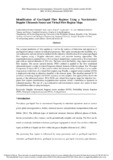JavaScript is disabled for your browser. Some features of this site may not work without it.
| dc.contributor.author | Nnabuife, Godfrey | |
| dc.contributor.author | Pilario, Karl Ezra | |
| dc.contributor.author | Lao, Liyun | |
| dc.contributor.author | Cao, Yi | |
| dc.contributor.author | Shafiee, Mahmood | |
| dc.date.accessioned | 2019-05-22T14:53:13Z | |
| dc.date.available | 2019-05-22T14:53:13Z | |
| dc.date.issued | 2019-05-17 | |
| dc.identifier.citation | Nnabuife SG, Pilario KE, Lao L, et al., (2019) Identification of gas-liquid flow regimes using a non-intrusive Doppler ultrasonic sensor and virtual flow regime maps. Flow Measurement and Instrumentation, Volume 68, August 2019, Article number 101568 | en_UK |
| dc.identifier.issn | 0955-5986 | |
| dc.identifier.uri | https://doi.org/10.1016/j.flowmeasinst.2019.05.002 | |
| dc.identifier.uri | http://dspace.lib.cranfield.ac.uk/handle/1826/14195 | |
| dc.description.abstract | The accurate prediction of flow regimes is vital for the analysis of behaviour and operation of gas/liquid two-phase systems in industrial processes. This paper investigates the feasibility of a non-radioactive and non-intrusive method for the objective identification of two-phase gas/liquid flow regimes using a Doppler ultrasonic sensor and machine learning approaches. The experimental data is acquired from a 16.2-m long S-shaped riser, connected to a 40-m horizontal pipe with an internal diameter of 50.4 mm. The tests cover the bubbly, slug, churn and annular flow regimes. The power spectral density (PSD) method is applied to the flow modulated ultrasound signals in order to extract frequency-domain features of the two-phase flow. Principal Component Analysis (PCA) is then used to reduce the dimensionality of the data so as to enable visualisation in the form of a virtual flow regime map. Finally, a support vector machine (SVM) is deployed to develop an objective classifier in the reduced space. The classifier attained 85.7% accuracy on training samples and 84.6% accuracy on test samples. Our approach has shown the success of the ultrasound sensor, PCA-SVM, and virtual flow regime maps for objective two-phase flow regime classification on pipeline-riser systems, which is beneficial to operators in industrial practice. The use of a non-radioactive and non-intrusive sensor also makes it more favorable than other existing techniques. | en_UK |
| dc.language.iso | en | en_UK |
| dc.publisher | Elsevier | en_UK |
| dc.rights | Attribution-NonCommercial-NoDerivatives 4.0 International | * |
| dc.rights.uri | http://creativecommons.org/licenses/by-nc-nd/4.0/ | * |
| dc.subject | Doppler shift | en_UK |
| dc.subject | PCA | en_UK |
| dc.subject | S-shaped riser | en_UK |
| dc.subject | SVM | en_UK |
| dc.title | Identification of gas-liquid flow regimes using a non-intrusive Doppler ultrasonic sensor and virtual flow regime maps | en_UK |
| dc.type | Article | en_UK |
Files in this item
The following license files are associated with this item:
This item appears in the following Collection(s)
-
Staff publications (SWEE) [2825]

